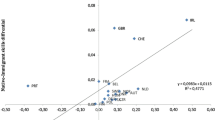Summary.
According to empirical studies, the wage differential by skills evolved non–monotonically in the past decades although the relative supply of skilled labor steadily increased. The present paper provides a theoretical explanation for this finding. In our setting, technological change intertemporally alters the human–capital investment incentives of heterogeneous individuals. As a consequence of changing incentives, the time path of the relative wage is U–shaped while there is a rise in the share of skilled workers.
Similar content being viewed by others
Author information
Authors and Affiliations
Additional information
Received: November 28, 2000; revised version: January 30, 2001
Rights and permissions
About this article
Cite this article
Meckl, J., Zink, S. Human–capital investment and the wage gap. Econ Theory 19, 853–859 (2002). https://doi.org/10.1007/s001990100181
Issue Date:
DOI: https://doi.org/10.1007/s001990100181




